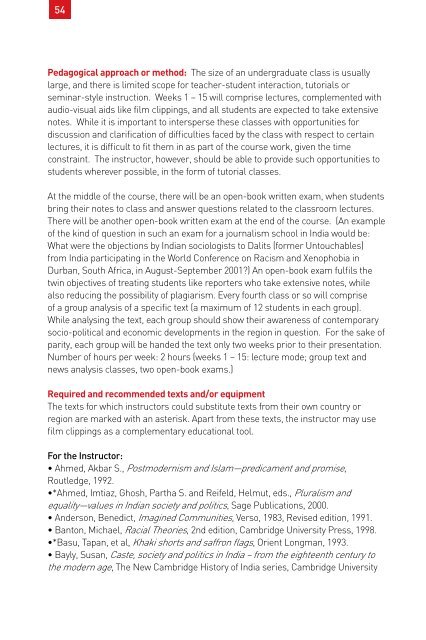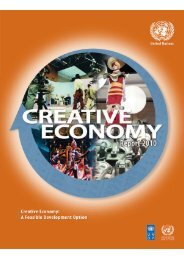Model curricula for journalism education for developing countries ...
Model curricula for journalism education for developing countries ...
Model curricula for journalism education for developing countries ...
You also want an ePaper? Increase the reach of your titles
YUMPU automatically turns print PDFs into web optimized ePapers that Google loves.
54<br />
Pedagogical approach or method: The size of an undergraduate class is usually<br />
large, and there is limited scope <strong>for</strong> teacher-student interaction, tutorials or<br />
seminar-style instruction. Weeks 1 – 15 will comprise lectures, complemented with<br />
audio-visual aids like film clippings, and all students are expected to take extensive<br />
notes. While it is important to intersperse these classes with opportunities <strong>for</strong><br />
discussion and clarification of difficulties faced by the class with respect to certain<br />
lectures, it is difficult to fit them in as part of the course work, given the time<br />
constraint. The instructor, however, should be able to provide such opportunities to<br />
students wherever possible, in the <strong>for</strong>m of tutorial classes.<br />
At the middle of the course, there will be an open-book written exam, when students<br />
bring their notes to class and answer questions related to the classroom lectures.<br />
There will be another open-book written exam at the end of the course. (An example<br />
of the kind of question in such an exam <strong>for</strong> a <strong>journalism</strong> school in India would be:<br />
What were the objections by Indian sociologists to Dalits (<strong>for</strong>mer Untouchables)<br />
from India participating in the World Conference on Racism and Xenophobia in<br />
Durban, South Africa, in August-September 2001) An open-book exam fulfils the<br />
twin objectives of treating students like reporters who take extensive notes, while<br />
also reducing the possibility of plagiarism. Every fourth class or so will comprise<br />
of a group analysis of a specific text (a maximum of 12 students in each group).<br />
While analysing the text, each group should show their awareness of contemporary<br />
socio-political and economic developments in the region in question. For the sake of<br />
parity, each group will be handed the text only two weeks prior to their presentation.<br />
Number of hours per week: 2 hours (weeks 1 – 15: lecture mode; group text and<br />
news analysis classes, two open-book exams.)<br />
Required and recommended texts and/or equipment<br />
The texts <strong>for</strong> which instructors could substitute texts from their own country or<br />
region are marked with an asterisk. Apart from these texts, the instructor may use<br />
film clippings as a complementary <strong>education</strong>al tool.<br />
For the Instructor:<br />
• Ahmed, Akbar S., Postmodernism and Islam—predicament and promise,<br />
Routledge, 1992.<br />
•*Ahmed, Imtiaz, Ghosh, Partha S. and Reifeld, Helmut, eds., Pluralism and<br />
equality—values in Indian society and politics, Sage Publications, 2000.<br />
• Anderson, Benedict, Imagined Communities, Verso, 1983, Revised edition, 1991.<br />
• Banton, Michael, Racial Theories, 2nd edition, Cambridge University Press, 1998.<br />
•*Basu, Tapan, et al, Khaki shorts and saffron flags, Orient Longman, 1993.<br />
• Bayly, Susan, Caste, society and politics in India – from the eighteenth century to<br />
the modern age, The New Cambridge History of India series, Cambridge University

















